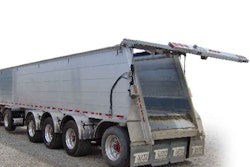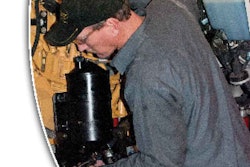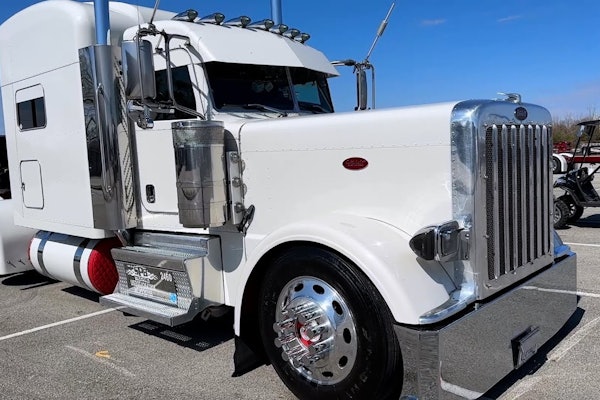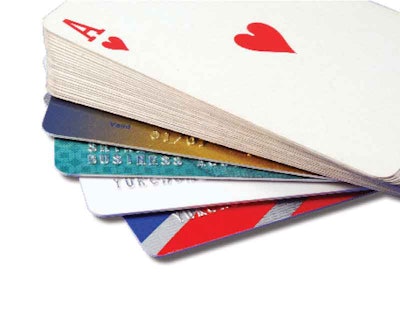
When owner-operator Mike Greenwell, leased to D&R Transport of Branson, Mo., had a heart attack that sidelined him for five months, he says, he took out a credit card for the first time. “I needed it to live on,” he says, until he could get back on the road. Since then, the debt he created has been a hardship.
As Greenwell and many other owner-operators have learned, a credit card can serve as a lifeline or financial drain, depending on how it is used. For some operators, a simple fuel card or other debit card works better, allowing no debt and thereby creating no interest expenses.
Almost two-thirds of owner-operators use a credit card for business, according to Overdrive research. If the account is in the operator’s business name, it is considered a business credit card. If it’s taken out in the operator’s personal name, more than likely it’s a standard consumer card. It’s up to the operator to use each accordingly for business or personal spending, which is best for accounting purposes and in the event of a tax audit.
An incorporated owner-operator business, says Angie Bruskotter of owner-operator financial services firm ATBS, should always use a business account for business charges and a personal account for non-business purchases.

“If you’re incorporated and you commingle business and personal funds,” she says, you risk losing the personal liability protection that is incorporation’s chief benefit.
But for the majority of owner-operators, as self-employed sole proprietors, the lines between business and personal lives are blurred, which is often reflected in the use of credit.
Mt. Pleasant, S.C.-based Paul Todorovich, today a company driver, never felt the need to incorporate his single-truck business when he was an owner-operator leased to Landstar and a member of America’s Road Team. Operating as a sole proprietor, he held two personal credit cards throughout most of the decades he ran.
“I never did get a separate credit card for my business,” he says. “And I know a lot of people talk about not commingling funds, but for me it was very simple. I’m single. It’s all coming out of and going into the same pocket.”
Fleet fuel cards for owner-operators leased to larger motor carriers, and trucking-specific fuel cards like those offered by Comdata for independents, provide accounting benefits and often a 6- to 7-cent-a-gallon price discount at truck stops. That’s because these cards are debit cards, so they qualify for the cash discount. The cards deduct fuel purchases from settlements or from independents’ accounts. One benefit of this is that it eliminates the risk of paying interest on borrowed money, as with credit cards.
An owner-operator leased to a large fleet also may get larger discounts depending on what the fleet has negotiated with the fuel stop.
If your credit score is 720 or better, instead of using fuel cards to buy fuel, you could qualify for a credit card with a generous benefits program. The benefits you gain can add up to more than the cash price discount of $1,200 to $1,400 a year available with a fuel card.
Small-business credit cards, because they are not covered under the 2009 Credit Card Act, lack the act’s consumer protections and therefore offer more profit potential for credit card companies. So as the companies aggressively market those cards, they’re offering big benefits to small businesses with excellent credit, from cash-back schemes to travel miles and points programs.
Capital One’s Business Platinum series offers businesses with credit at least equivalent to a 760 score either 1 percent cash back on all purchases or 3 travel miles for every dollar spent in a particular category. The cash-back card would return $600 yearly on $60,000 in fuel purchases using the example above. Choosing the miles version of the card, however, would net an operator 180,000 travel miles, worth a reward potential of up to $1,800 worth in airline tickets.
Such rewards are at best an ancillary benefit to an otherwise sound approach to cash flow. When using credit cards to charge for fuel and maintenance expenses, paying bills off before interest accrues is key. Otherwise you run the risk of digging yourself a deep costly hole.

In December 2008, California-based Marten Transport leased owner-operator Thomas Blomberg jumped at an offer of a one-year no-interest introductory period on a $26,000 credit line with a Bank of America-issued card. He needed the credit for an in-frame on his 2003 Freightliner Columbia. Over the next year, as his miles decreased with the reduction in long-haul freight, he was unable to pay the nearly $20,000 bill off before interest began accruing.
“I’m in a big hole with Bank of America,” he says. “I’ll be paying for this for years and years on the interest.”
As an owner-operator, Todorovich “used a credit card only when I was far away from home and needed a repair.” He’d spend the following 30 days running as hard as he could to pay the bill before interest charges kicked in.
He hasn’t paid a dime of interest since 2004, when his previous truck was paid off, he says. “If I don’t have the money, I don’t buy it.”
Even prior to the recession, 10 percent of all owner-operators, according to Overdrive research, considered balances on their credit cards to be too high and difficult to manage.
Greenwell estimates he charged $3,000 on his first credit card after his heart attack. Making only the minimum payment once he got back on the road, he found his balance barely changed from month to month because of a high interest rate. “I got the rate reduced to 7 percent when I closed the account, finally,” he says. “Now I’m paying about $150 a month” toward gaining zero balance.
He adds, “I don’t ever want another credit card. If you can’t pay cash for what you’ve got to buy, you don’t need to have it.”
Prepaid debit cards not just for fuel
Comdata and similar fuel cards are available to independents looking to combine maximum fuel discounts with the accounting aspects of a debit card tied to a traditional bank account.
 Howard Salmon finds the TCH fuel card useful.
Howard Salmon finds the TCH fuel card useful.For single-truck and other small fleets, says Comdata Product Executive Cory Sickles, the Comdata discount fuel network can be opted into for discounts over the cash price. “You will not pay the credit card price at a truck stop in our network,” he says.
As part of Mastercard’s Maestro point-of-sale network, all Comdata cards are useable anywhere the Maestro logo appears. “That allows [cardholders] to go to Target or Walmart,” says Sickles, as well as “anyone that would accept some kind of point-of-sale debit, ATMs.”
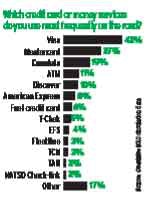
Though fuel cards offer various discounts, such as for lodging and maintenance, to date none appears to offer cash-back or travel-reward programs like a credit card, though that may be coming. Many banks now offer debit card reward programs.
Fuel card resources
Comdata:
FleetOne Truckers Advantage:
TCH: www.tch.com
Bend plastic to your needs
Bankrate.com offers these tips for using credit cards in your business:
BUY ONLY WHAT’S NEEDED. Take a hard line on defining “need” and avoid using credit for things – like that flashy 22-inch chrome bumper – that are not essential for the business.
SPEND MONEY TO MAKE MONEY. Purchases should be “helping you make more money than you originally spent,” notes the website. If you can’t expect to bring in enough to cover the expense, don’t buy it. With certain expenditures, like wide single tires or an auxiliary power unit, the return on investment might take months, even years. Track your fuel economy and other performance indicators to determine the speed and amount of the payback.
PAY MORE THAN THE MINIMUM. If you can’t pay off monthly balances entirely, “pay as much down on your credit card balance as possible without hurting your business nest egg.” Paying at least twice the minimum should ensure your balance falls steadily.
BREAK THE HABIT. Once you’re established, “wean off the business credit card,” which can be as habit-forming as nicotine. Invest saved cash in a maintenance fund.
Comparing card benefits
FleetOne Truckers Advantage fuel card
Interest rate N/A, operates like a debit account
Benefits 6-7-cent/gal. cash price discount in-network
+ 2-cent/gal. additional discount with rebates;
access to parts/maintenance savings programs
Potential disadvantage Transaction fees for out-of-network fuel purchases
Yearly potential benefit from fuel purchases $1,700 in fuel savings
Annual fee OOIDA membership: $45; $25 sign-up fee unless done in person at one of three
industry events
Website to apply www.truckersadvantage.com
Capital One Business Platinum
Preferred No-Hassle Miles card
Interest rate 0% six-month intro rate, 14.99% and up
thereafter, variable
Benefit features Points per dollar spent redeemable in travel services (air, lodging, rental vehicles)
Potential disadvantage Low-limit, high-rate card; excellent credit needed
Yearly potential benefit from fuel purchases $1,800 maximum in travel services
Annual fee None
Website to apply www.capitalone.com/smallbusinesscards
Miles by Discover consumer card
Interest rate 0% six-month intro rate, 10.99% and up thereafter, variable
Benefit features Points per dollar spent redeemable in travel services (air, lodging, rental vehicles) and restaurant purchases
Potential disadvantage Benefits unlikely to exceed fuel-card cash price discount benefit
Yearly potential benefit from fuel purchases $600 or more in travel services (air, lodging,
rental vehicles)
Annual fee None
Website to apply www.discovercard.com/miles
Chase Ink Cash business card
Interest rate Six-month intro 0% rate, 13.24-19.99%
variable thereafter
Benefit features 3% cash back on up to $2,000 in qualified
purchases each billing cycle, including fuel;
1% back on all others; $100 intro cash-back offer
Potential disadvantage Low-limit, high-rate card; requires good credit
Yearly potential benefit from fuel purchases $1,180 in cash-back rewards first year,
$1,080 thereafter
Annual fee None
Website to apply www.chasecreditcards.com,
click “Business Credit Cards”
Many credit cards have programs that reward use of the card with merchandise, travel credits or other incentives. For business use, cash-back rewards are usually the most measurable and cost-effective. Bankrate.com offers comparisons of current rewards and other terms for leading cards. Note that high annual fees and interest rates can wipe out the value of rewards.
Credit’s Full Cost
If you’re like the 40 percent of owner-operators with an outstanding balance and, according to Overdrive research, owe upwards of $5,000 on at least one card, you can use Bankrate’s credit card payment calculator to see the true cost of making only the minimum payment. If you’re surprised at how high it is, let that motivate you to get out of debt as quickly as possible. Visit Bankrate.com, and search “Credit card payment calculator.”




